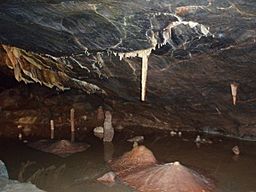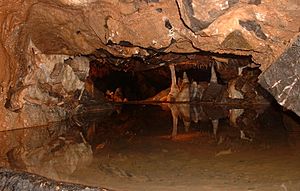Gough's Cave facts for kids
Quick facts for kids Gough's cave |
|
|---|---|

Stalagmites and stalactites in Gough's cave
|
|
| Location | Cheddar |
| Depth | 115 m (377 ft) |
| Length | 3,405 m (11,171 ft) |
| Discovery | 1892 |
| Geology | Limestone |
| Access | Show cave open to the public; greater part by diving only |
| Cave survey | University of Bristol Spelaeological Society |
| Registry | Mendip Cave Registry |
Gough's Cave is an amazing natural wonder located in Cheddar Gorge. You can find it in the Mendip Hills near Cheddar, England. This huge cave is about 115 m (377 ft) deep and 3.405 km (2.12 mi) long. It has many large rooms and cool rock formations. The Cheddar Yeo river flows through it. This is the biggest underground river system in Britain!
Contents
Discovering Gough's Cave
The first parts of Gough's Cave were known even before the 1800s. People called it Sand Hole back then. A retired sea captain named Richard Cox Gough lived in Cheddar. Between 1892 and 1898, he explored and dug out more of the cave. He opened these new areas to the public. The part you can visit today, called Diamond Chamber, was found by him. Electric lights were added to the cave in 1899.
The cave can sometimes flood, usually for a day or two. But during the Great Flood of 1968, the water stayed for three days! More of the cave's flooded parts were found and explored between 1985 and 1990.
Ancient Discoveries in the Cave
Gough's Cave is famous for the ancient bones found inside. Both human and animal skeletons have been discovered here.
Meet Cheddar Man
In 1903, the bones of a human male were found in the cave. He is now known as Cheddar Man. He is Britain's oldest complete human skeleton! Scientists believe he lived around 7150 BC. Studies of his DNA suggest he likely had green eyes and dark, curly hair. He probably also had dark skin.
Cheddar Man's remains are now kept at the Natural History Museum in London. Other human bones have also been found in the cave. In 2010, more human bones were studied. They were found to be about 14,700 years old. This means they are from around the end of the last ice age.
Ancient Tools and Rope Making
In 2020, scientists found a 40,000-year-old mammoth tusk. It was about 20 centimeters long and had four holes drilled into it. Experts think it was a tool for making rope! Grooves around each hole would have held plant fibers in place. This amazing tool was found in another cave called Hohle Fels.
Scientists used a bronze copy of the Hohle Fels tool. They were able to make twisted strands of twine. This is called experimental archaeology. A similar tool, made from reindeer antler, was found in Gough's Cave. This one was about 15,000 years old. Finding these tools in different places shows that rope-making was important long ago. Ropes could be used for fishing nets, traps, bows and arrows, and even clothes. They also helped people carry food or pull heavy objects like sleds.
Exploring Gough's Cave
The first 820 m (2,690 ft) of Gough's Cave are open to visitors. This part is called the show cave. It has the most impressive rock formations. Most of the cave's length is a river passage. This part can only be reached by cave diving.
Beyond the Show Cave

Gough's Cave has long sections of river passage that are completely underwater. Cave-divers enter the water through a narrow passage called Dire Straits. This leads them into the wide river passage. Divers have explored about 335 m (1,099 ft) downstream. Going upstream, a 150 m (490 ft) dive leads to a 20 m (66 ft) long room called Lloyd Hall.
Another dive of 140 m (460 ft) takes divers to Bishop's Palace. This is a huge room, about 60 m (197 ft) long and 25 m (82 ft) wide. It is the biggest room found in the Cheddar caves so far. Further on, there are three small pools called the Duck Ponds. These lead to another underwater section called Sump 2. This sump is about 27 m (89 ft) deep and 150 m (492 ft) long.
After Sump 2, divers reach an air-filled section called Sheppard's Crook. This leads to Sump 3. This sump is very deep, about 55 m (180 ft). At its lowest point, it is about 30 m (98 ft) below sea level! After Sump 3, a wide passage continues for 370 m (1,214 ft). It then reaches a blockage, still underwater.
Images for kids




